Going on an Indian Canyons hike means exploring the world’s biggest natural palm oasis and cool mountain-fed streams, all tucked away in rugged canyons. In this guide, we detail the best Indian Canyons trails to experience the desert magic and diversity of Palm Springs.
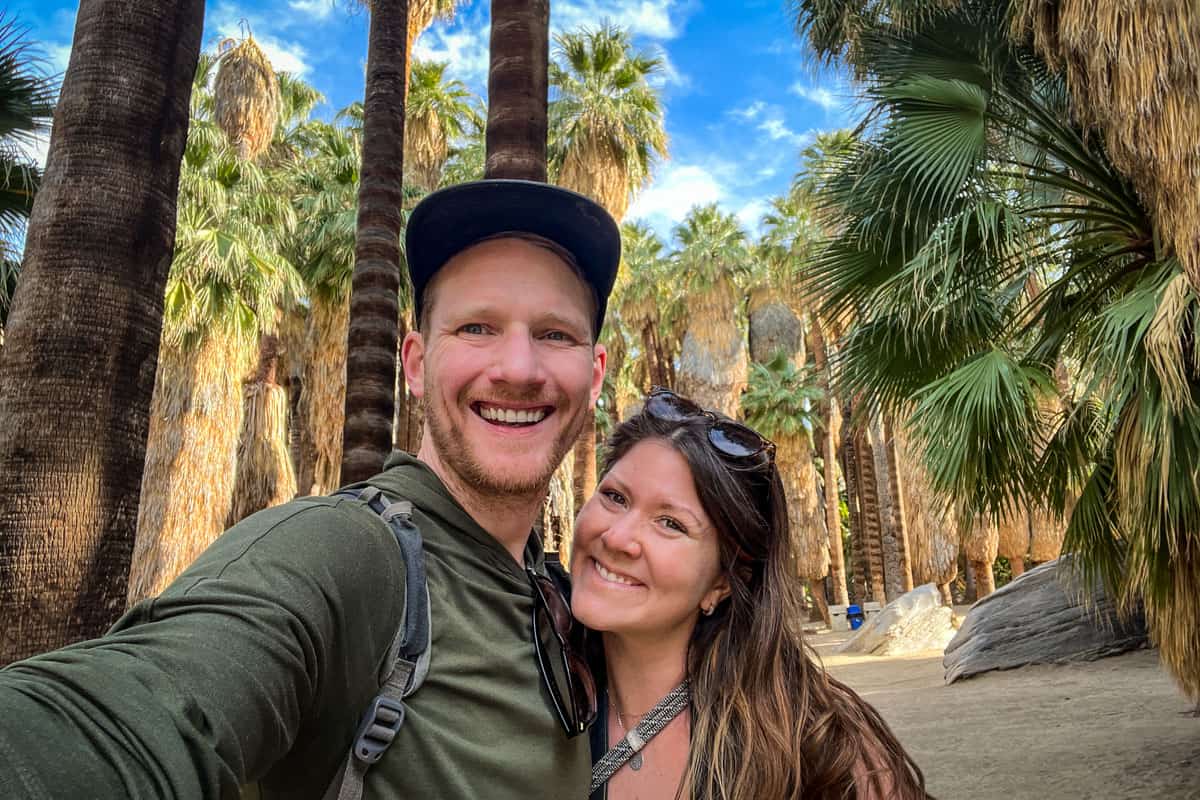
A gem for outdoor enthusiasts, history buffs, and cultural lovers alike, Indian Canyons is filled with hiking trails, streams and oases, unique desert scenery, wildlife galore, and Native American artifacts. Plus, of course, thousands of fan palm trees.
The largest, oldest natural palm oasis on Earth is right here, nestled inside Indian Canyons. It’s no wonder how the city got its name!
Amazingly, this unlike-anywhere-else place is minutes from downtown Palm Springs, nestled at the base of the San Jacinto Mountains.
With several canyons and a robust network of trails, the best way to explore is to head out on an Indian Canyons hike.
Indian Canyons Guide
- Indian Canyons overview
- Indian Canyons stats
- Best hikes in Indian Canyons
- Tips for hiking in Indian Canyons
- Best time to visit
- FAQs
- How to get there
- Where to camp
- What to pack

Indian Canyons overview
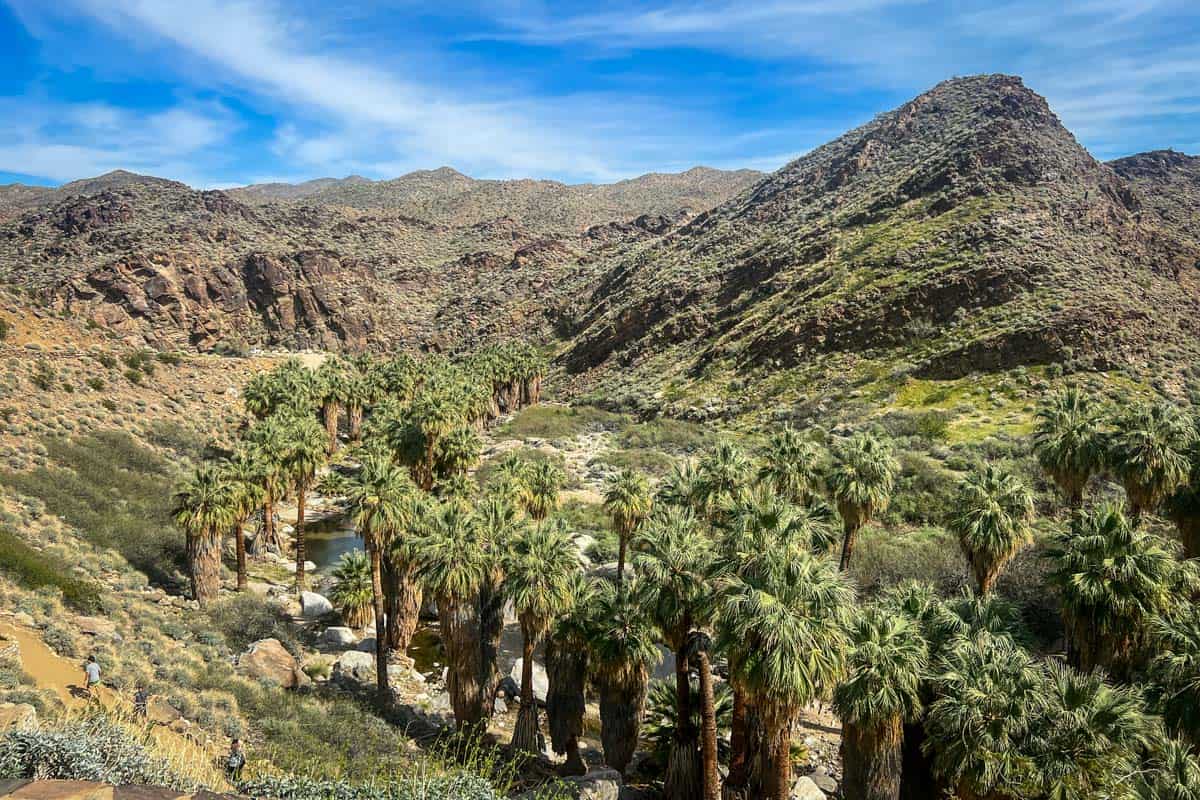
The ancestral home of the Agua Caliente Band of Cahuilla Indians, people have long known that the Indian Canyons are incredibly special.
Three major, distinctly different canyons comprise the area: Andreas, Murray, and Palm.
Over 60 miles of hiking trails traverse them, crossing streams, passing through lush groves of tremendous palms, and leading to waterfalls and even pools. All framed by both snow-capped peaks and stark desert.
The landscape is almost surreal or otherworldly, yet it’s as traditional as it gets, having remained largely untouched for centuries.
Indian Canyons stats
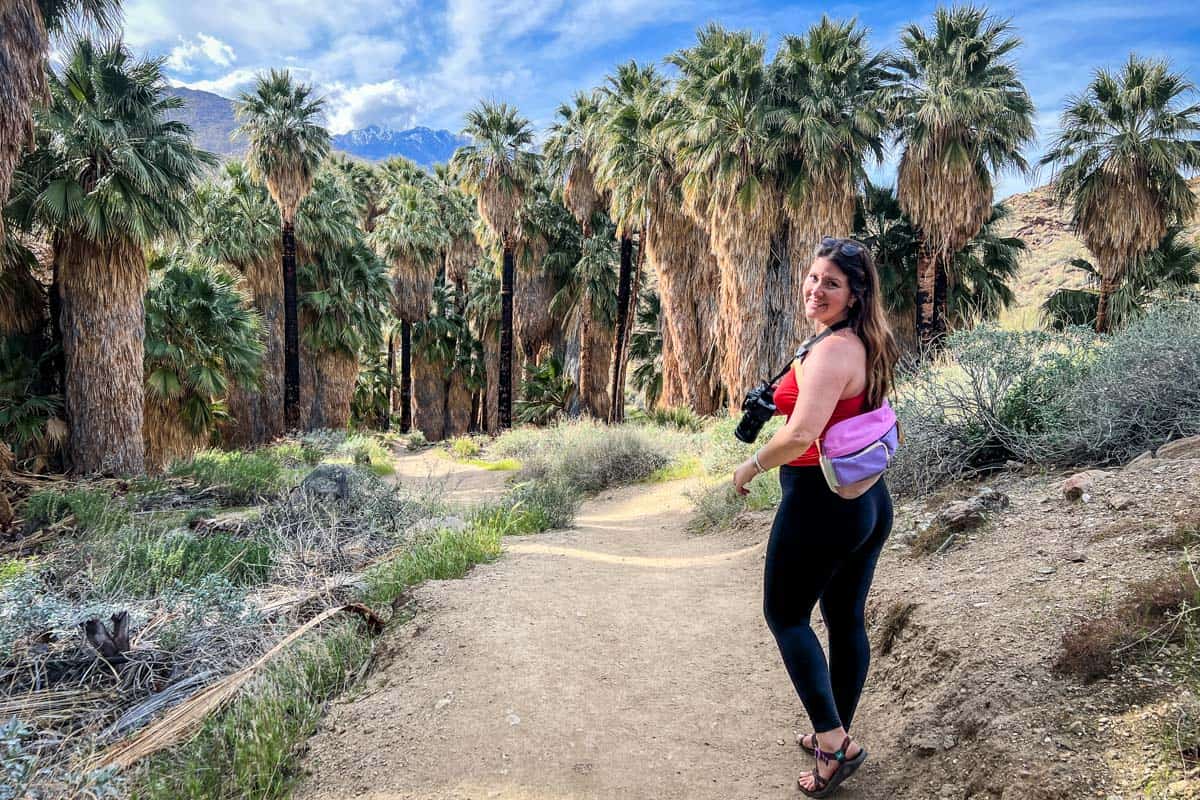
Here are all the important things to know about Indian Canyons:
- Location: Agua Caliente Indian Reservation near Palm Springs, California
- Entrance fee: $12 per person
- Hours: 7:30 a.m. – 5 p.m. (weekends only in the summer)
- Good to know: Dogs aren’t allowed
- Google Maps location
Best hikes in in Indian Canyons
With about 60 miles of trails to choose from, there’s an Indian Canyons hike for everyone. A short, straightforward trail to the palm oasis, wildflowers galore, or sweating your way to secluded swimming holes, you’ll find it here.
Palm Canyon hike

- Distance: 2 miles, out and back
- Elevation gain: 209 feet
- Difficulty: easy
- View the trail notes
If you’re short on time and can only fit in one Indian Canyons hike, Palm Canyon is an excellent choice.
In just one short mile, you’ll reach the world’s largest and oldest natural palm tree oasis. Technically, they’re Washingtonia filifera palms (desert fan palms, or California palms). The more you know!
The trail starts at the trading post and drops down into the palm grove almost immediately. Aside from there being a LOT of palm trees (over 2,500!), they’re enormous—much bigger than you expect. Their bright green color also adds a striking contrast to the muted desert landscape.
Inside the oasis, you’ll feel a noticeable coolness, thanks to the perpetual shade and gently running stream. The hike is short and sweet, but the ground is rocky and uneven, so it provides just enough of a challenge to feel accomplished.
The Palm Canyon Trail actually spans 15 miles, going all the way to Highway 74. However, the vast majority of visitors only hike the first mile to the East Fork junction, then turn around. Keep this in mind if you have the time and want to explore off the beaten path.
Don’t miss West Fork Falls, just past the restrooms near the trading post.
Andreas Canyon hike
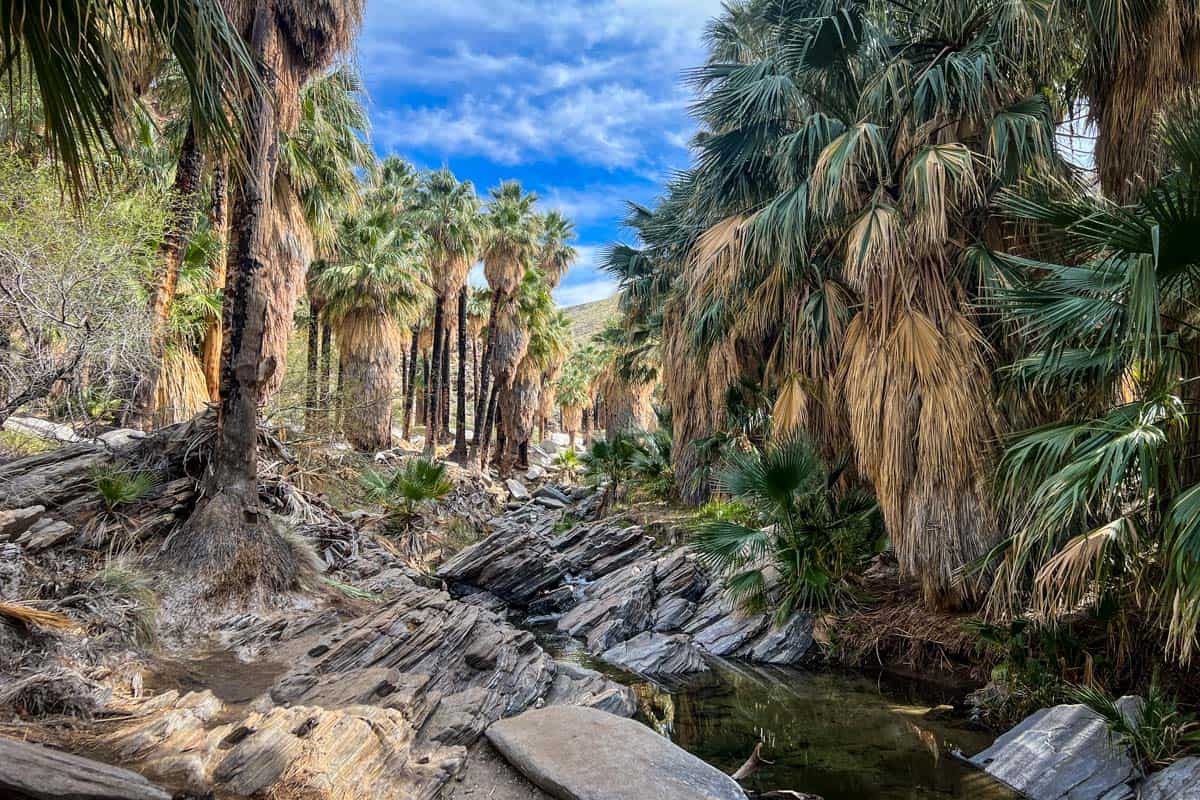
- Distance: 1-mile loop
- Elevation gain: 177 feet
- Difficulty: easy
- View the trail notes
Andreas Canyon is the shortest and easiest Indian Canyons hike. The trail takes you along both sides of Andreas Creek, crossing it at the ‘end’ of the loop.
The first half of the hike follows the creek at the bottom of the canyon, with some shade. Once you cross it, you’ll head back toward the parking lot via a ridge, walking above the palms and overlooking the canyon. This section is more exposed, marked by soaring rock formations.
As you walk across expanses of rock, look down. The near-perfect circular holes in the bedrock are ancient mortars, a method of grinding and preparing food.
Look UP, too. The stone cottages that practically blend right into the canyon are perhaps the most exclusive homes in Southern California (and that’s really saying something!).
Built in the 1920s by the Andreas Club, they can’t be bought, sold, or rented, and new owners must be nominated and approved by existing club members.
Especially considering it’s just one mile, this trail packs in an impressive array of culture and scenery!
In addition to the trail, Andreas Canyon has a large picnic area. It’s a lovely lunch spot, as it’s particularly colorful. With over 150 plant species in just this canyon, that’s especially true when spring wildflowers are in bloom.
Note that rattlesnake sightings seem to be especially frequent on this trail—perhaps because of the abundance of larger rocks.
Victor Loop
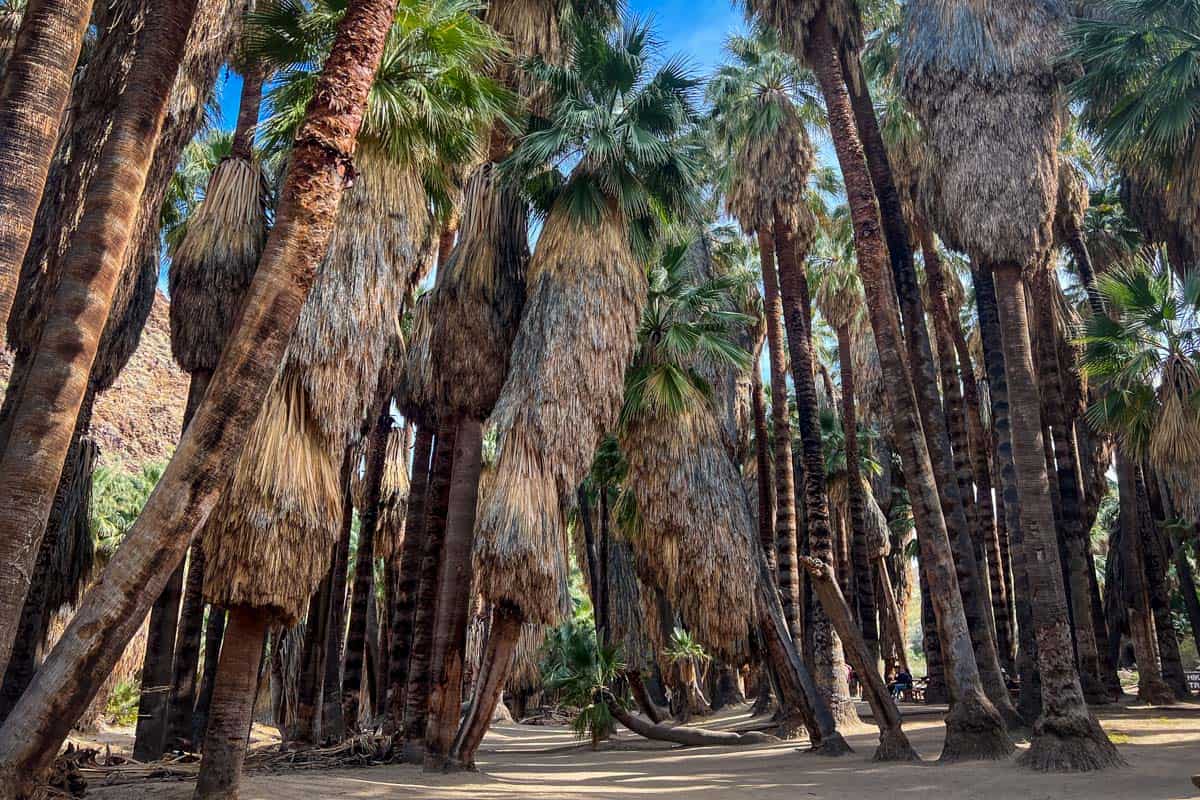
- Distance: 2.7-mile loop
- Elevation gain: 365 feet
- Difficulty: Moderate
- View the trail notes
Considered one the most scenic trails in Indian Canyons, Victor Loop really shows off the area’s unique scenery.
It takes you up a ridge overlooking Palm Canyon, offering fantastic panoramic views of the palms below and the surrounding mountains, cactus, and rugged canyons all at once.
The first 1.1 miles follow Palm Canyon Trail. From there, take a sharp switchback to get onto Victor Loop on the ridge and start heading back toward the parking lot.
While the Victor Loop stretch is rated moderate because it’s completely exposed and has more rugged terrain with a bit of a climb, the first half of the hike through Palm Canyon is easy.
Because of this, depending on what time you start your hike, you may want to do the loop in a clockwise direction. This puts the shaded, easier portion at the end, rather than the beginning.
Insider tip: if it recently rained or is generally a wetter year, connect to the Fern Canyon Trail near the end of the loop, rather than heading back to the parking lot. Instead of taking the last sharp left, you’ll take a hard right.
When there’s enough moisture, large, lush green maidenhair ferns come to life in Fern Canyon’s small palm oasis.
Murray Canyon to Seven Falls
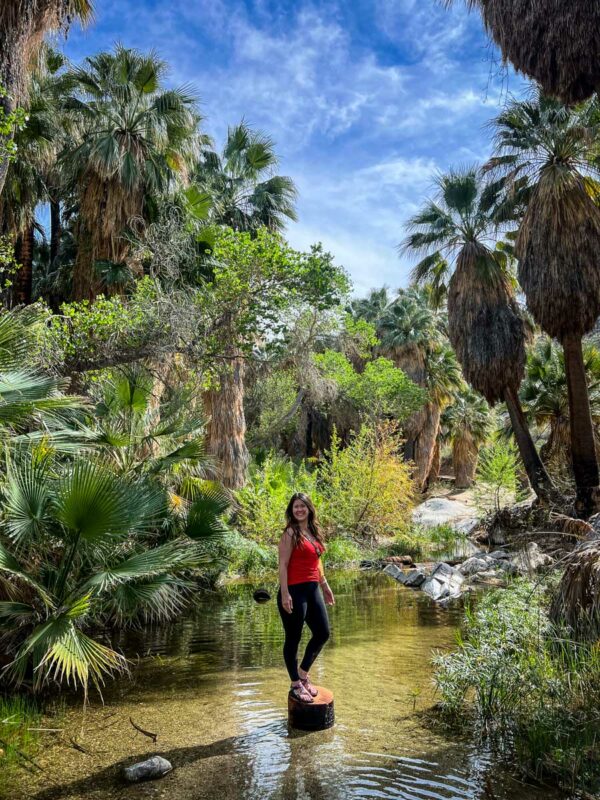
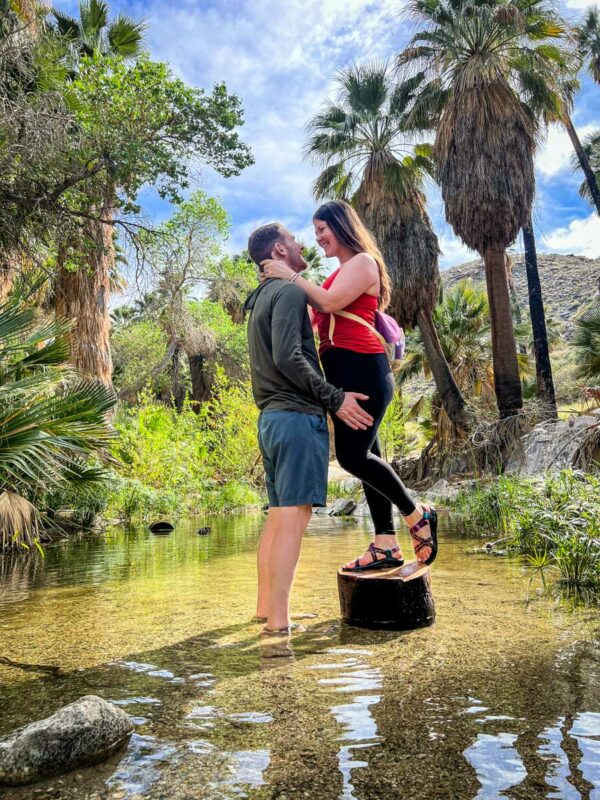
- Distance: 3.7 miles, out and back
- Elevation gain: 538 feet
- Difficulty: moderate
- View our trail guide
On this Indian Canyons hike, you really get to see the area’s incredible diversity. The trail starts out in the open desert, crossing soft, beach-like sand before reaching a relatively small grove of palms.
From there, you’ll cross the mountain-fed stream upwards of a dozen times en route to the trail’s star attraction, Seven Falls (also sometimes called Murray Canyon Falls). From upper vantage points, you can see the seven pools that give the cascade its name.
Unsurprisingly due to the abundance of water, bright yellow and purple wildflowers really pop in Murray Canyon in the spring and summer.
Also because of the water, we recommend water-friendly hiking shoes for this particular trail.
On the way back from Seven Falls, you can also hop on the Coffman Trail to add less than 0.3 miles to your total distance. The addition is easy-going and shows off desert scenery away from the stream.
As a bonus, this is one of the least-crowded trails in Indian Canyons (although for the life of us, we don’t understand why!).
Trading Post to Stone Pools
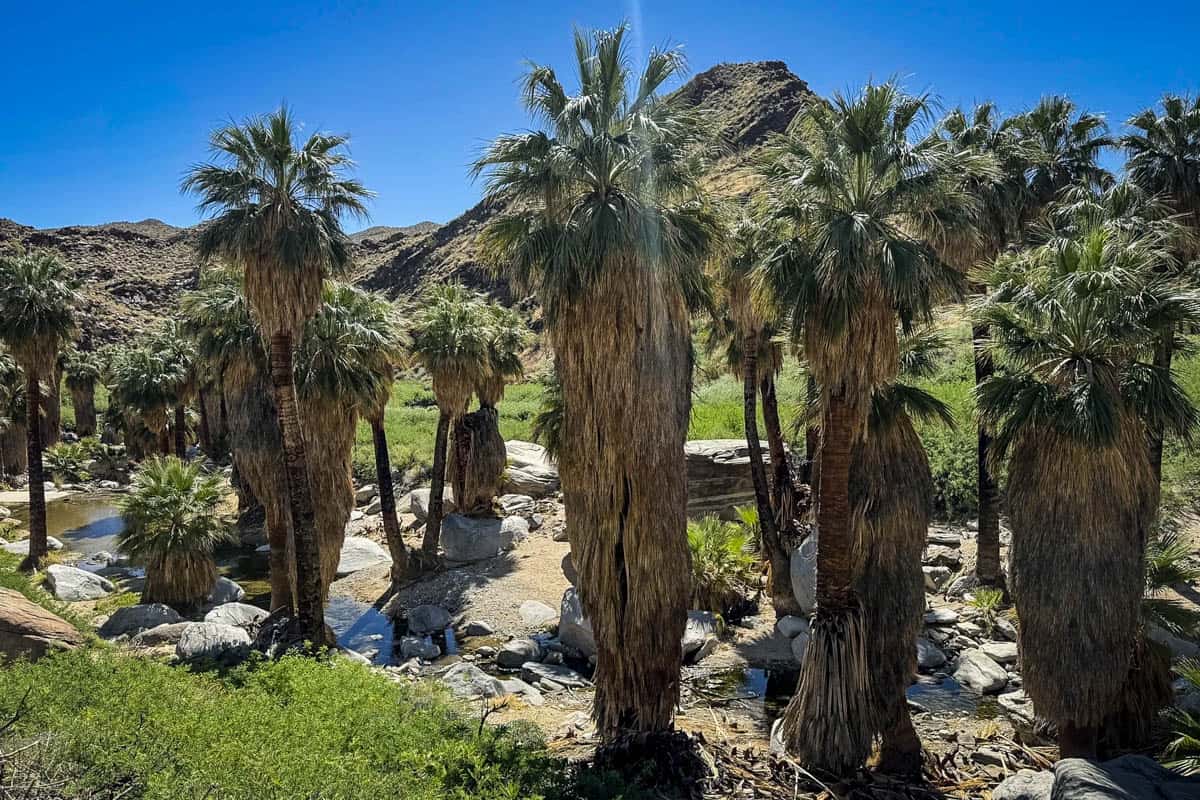
- Distance: 5.9 miles, out and back
- Elevation gain: 948 feet
- Difficulty: moderate
- View the trail notes
If you want the classic scenery of Indian Canyons but also a hike more challenging than Palm Canyon (and swimming holes!), consider hiking to the Stone Pools.
You’ll start out on Palm Canyon Trail and connect to the Stone Pools trail junction about 1.5 miles in. This transition takes you up above the desert floor, leaving the shady palm grove behind and swapping it for wide-open views of the canyons.
After another 1.5 miles—and the bulk of the trail’s elevation gain—you’ll descend into the canyon again to reach the pools.
On warm days, this hike feels more challenging than ‘moderate’ once you leave the cool palms. The sparkling clear pools are the perfect reward, however, especially because there’s an excellent chance you’ll have them all to yourself.
Like most of the water in Indian Canyons, the season and climate affect the experience at the pools. During wetter periods, the pools are plentiful and deep. In drier times, though, you’ll find fewer and shallower pools.
Psst! Check out our round up of the best Palm Springs hikes before you go!
Tips for hiking in Indian Canyons
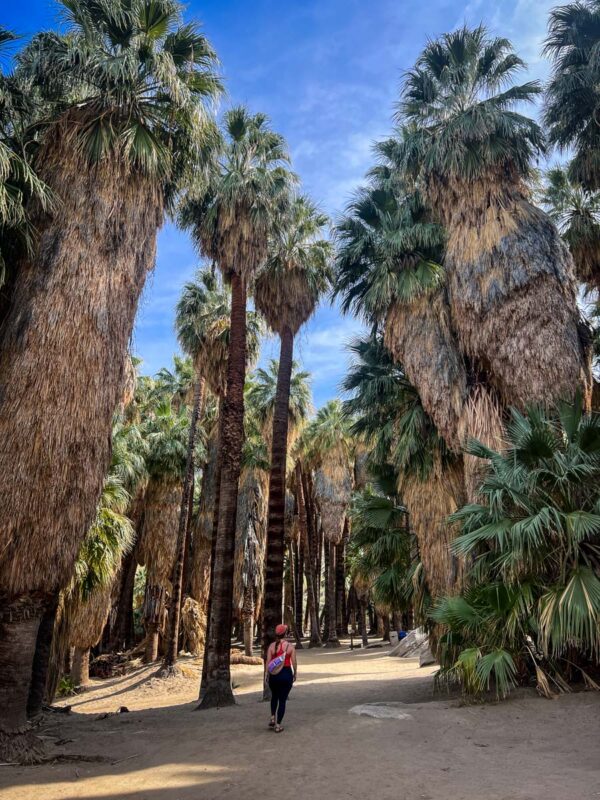

- The bathroom situation isn’t ideal. There are only porta-potties available, and as you can imagine, they get pretty nasty sitting in constant heat and sunshine. Bring some hand sanitizer or wet wipes in case you need to use them.
- Arrive early. Indian Canyons closes temporarily when it reaches capacity, and visitors will be turned away. Note that even purchasing tickets online in advance doesn’t guarantee entry.
- Do not go to Indian Canyons when there’s a risk of flash flooding. Flash floods can occur any time within several hours of heavy rain, and being in a canyon is especially dangerous.
- Wear closed-toe water shoes. We’re big fans of Chacos, but you want to protect your feet against desert critters here.
- Consider bringing trekking poles. They’re especially helpful with stream crossings when water levels are up.
- Yield to horses. The trails in Indian Canyons are equestrian-friendly, so there’s an excellent chance you’ll hike alongside horses.
- Join a free ranger-led hike or talk. This is a fantastic way to learn more about Indian Canyons and the greater Palm Springs area, especially its geology and the native plant and wildlife.
Best time of year for hiking in Indian Canyons
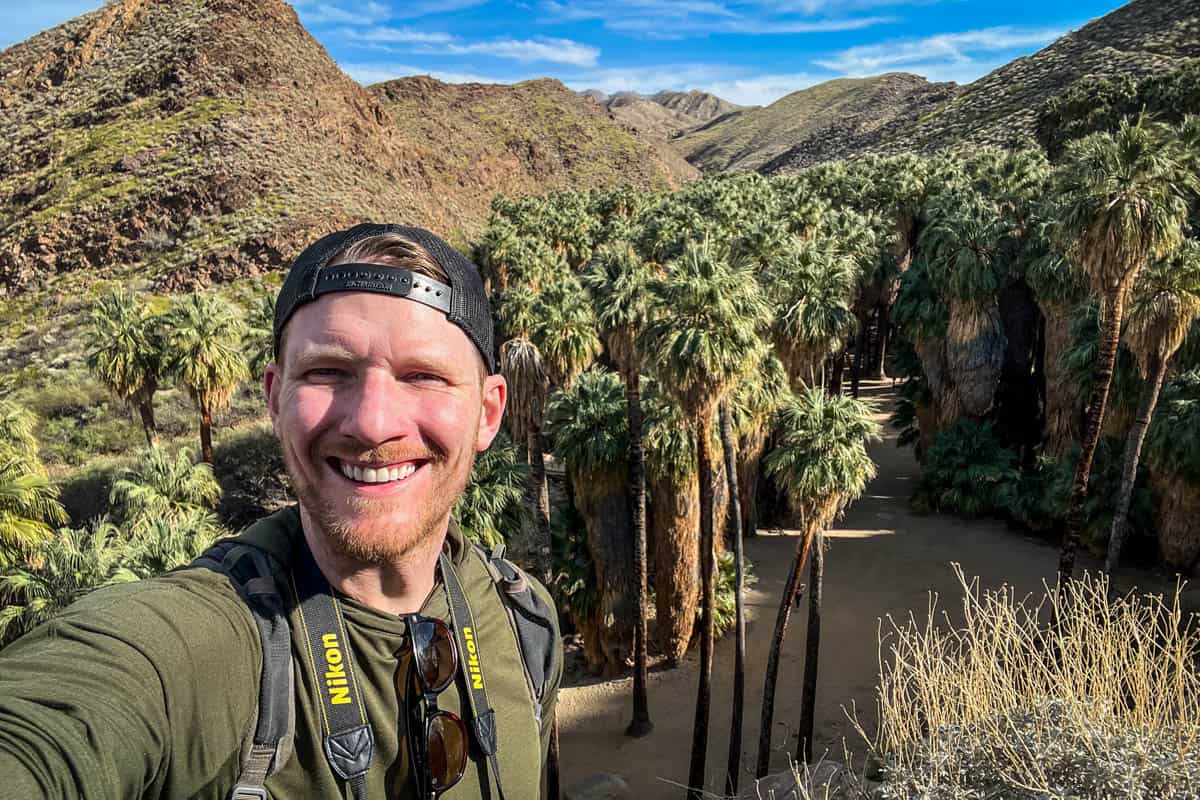
The best time to explore Indian Canyons is October through April. From mid- to late spring through mid-fall, high temperatures often soar above 100 degrees. It rarely cools down below the 70s overnight in the summer, so hitting 90 by 9:00 am isn’t at all uncommon!
Indian Canyons doesn’t open for the day until 8:00 am and it closes at 5:00 sharp. That means getting a super early or late start to beat the heat is out of the question. With that said, avoid hiking here in the summer if at all possible.
If you do plan to visit in the summertime, note that Indian Canyons is only open Friday through Sunday from July 5 to September 30.
If you’re hoping to see a bunch of flowing water, plan your visit for February through April, or a day or two after heavy rain. And if spring wildflowers are a priority, go between mid-March and early May.
FAQs about Indian Canyons
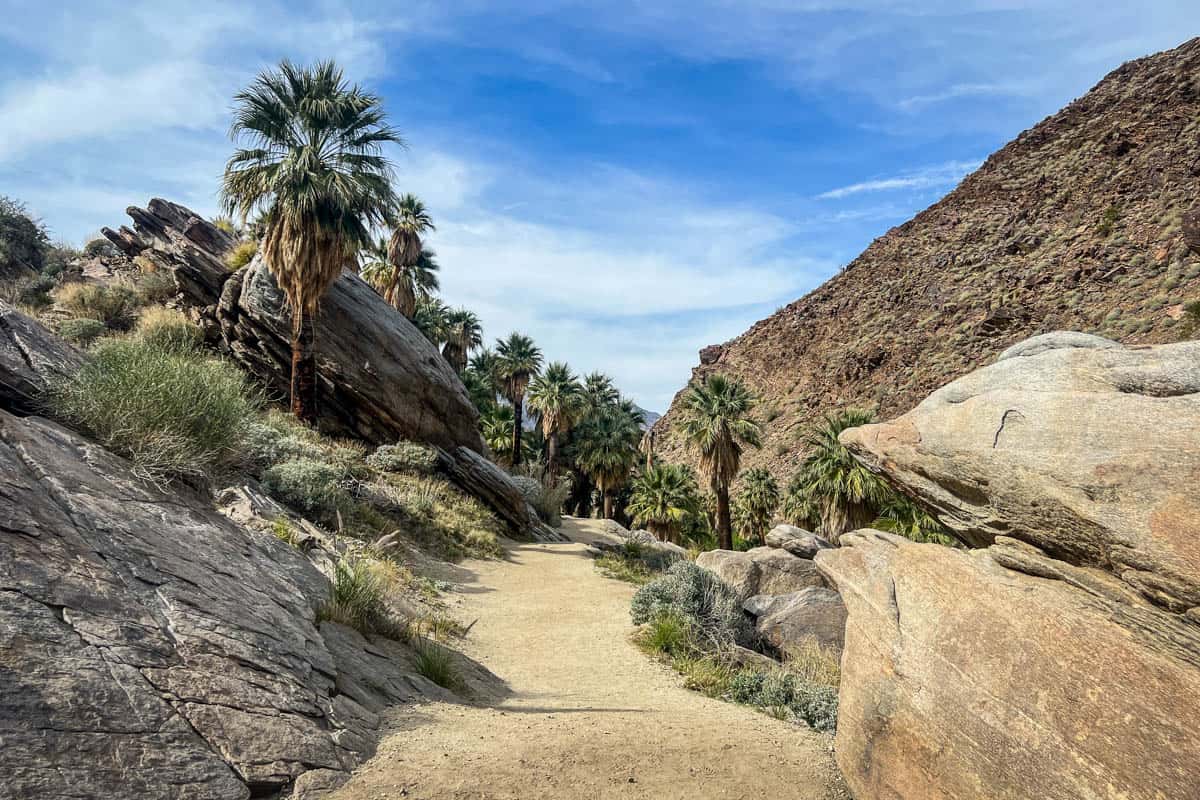
Here are some of the most useful things to know before heading out to Indian Canyons.
Which is better: Indian Canyons or Tahquitz Canyon?
We’ve hiked in and enjoyed both, but they’re quite different. One isn’t necessarily ‘better’ than the other, so it’s difficult to make a single recommendation.
If you can only visit one, consider the biggest differences.
Indian Canyons has numerous trails and even separate canyons, whereas Tahquitz Canyon has one main hike and attraction: the waterfall. With that said, the opportunity to swim in its base is pretty alluring.
On the other hand, if you want to ride horseback, only Indian Canyons allows that.
Personally, if we only had time for one, we’d choose Indian Canyons for the bigger variety of trails and scenery—but again, we enjoyed both and each has plenty of ‘pros.’
Both offer beautiful wildflowers, refreshing water, and easy access from downtown. If you end up visiting both, head to Indian Canyons first. You’ll get a coupon for discounted admission at Tahquitz Canyon.
What animals are in the Indian Canyon?
Several species of wildlife call Indian Canyons home, including rattlesnakes, lizards, cottontail rabbits, coyotes, mule deer, bighorn sheep, and mountain lions.
You’re far more likely to see lizards and rabbits than anything else, but still, always keep your eyes peeled and ears open—and watch your step!
Are dogs allowed at Indian Canyons?
No animals of any kind, including dogs, are permitted inside Indian Canyons.
How to get to Indian Canyons
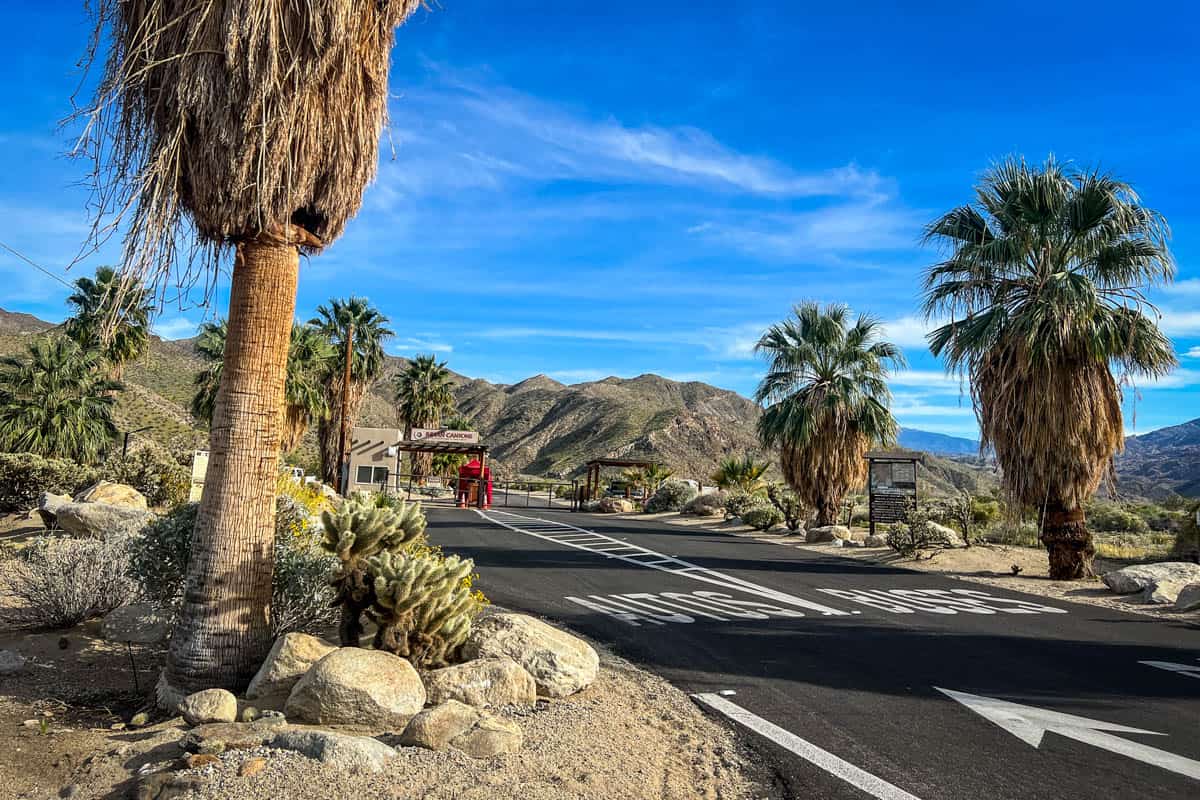
Indian Canyons is in South Palm Springs, about 10 minutes south of the downtown core. The entrance is right off of South Palm Canyon Drive, the city’s main drag.
The first parking lot is about one mile past the entrance, with Andreas Canyon and Murray Canyon trailheads. 1.5 miles further is the second parking lot and the trading post, as well as the famous Palm Canyon.
Where to camp nearby
If you’re someone who enjoys more rustic or dispersed camping, unfortunately, there’s not much convenient to Indian Canyons. However, there are some very nice RV parks.
- Cathedral Palms RV Resort: 15 minutes from Indian Canyons, with an outdoor pool, kiddos’ wading pool, and space for even the biggest rigs
- Happy Traveler RV Park: Loads of amenities including an outdoor pool and wi-fi, within walking distance of downtown Palm Springs
Alternatively, you can find amazing camping in Joshua Tree National Park, about one hour from Palm Springs. A little over an hour in the opposite direction is San Bernardino National Forest, with a variety of campgrounds including free camping.
What to pack for hiking at Indian Canyons
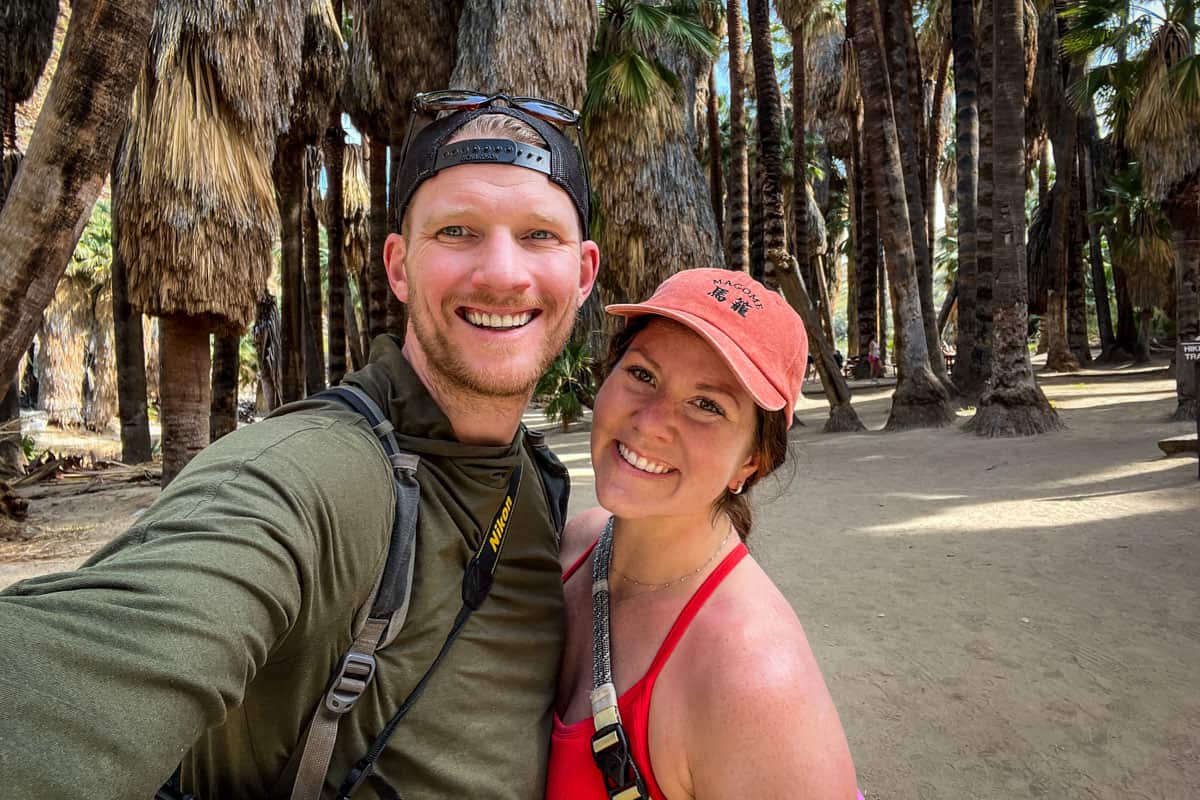
- Navigation*: we recommend using Alltrails+ to download the offline trail map
- Get your first week of using Alltrails+ for FREE when you sign up using our link!
- Hiking daypack
- Water bottles and/or bladder for your Camelbak
- Sun protection: sunscreen, hat, sun glasses
- Bug repellant
- Headlamp (if hiking near dawn or dusk)
- Camera/tripod (this one’s our favorite for hiking)
- Hiking layers (here is a great resource if you’re wondering what to wear hiking)
- Comfortable hiking boots or shoes
- We recommend Chacos for hiking in the desert like this as they are super versatile and you can get them wet when necessary (like for the Murray Canyon hike)
- Hiking poles (optional)
- Plenty of snacks: check out our favorite hiking snacks here!
Be sure to download our FREE hiking packing list before your next trip and never leave another essential behind again!
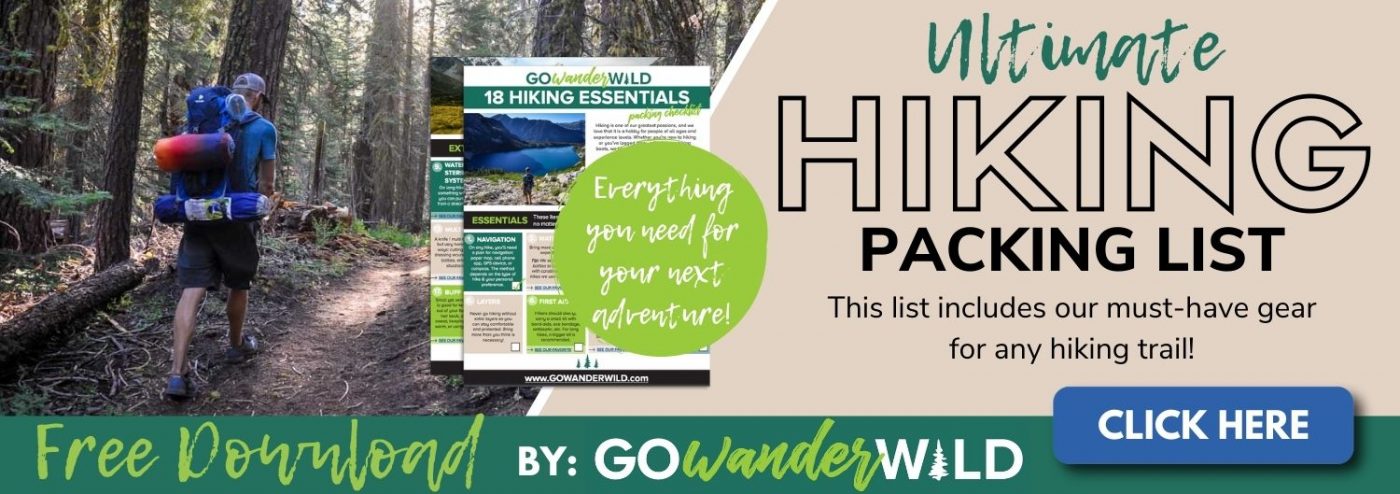

You may also like…
- Tahquitz Canyon Waterfall Hike: Palm Springs Trail Guide
- Beginner Hiking Tips: Essential Info & Preparedness
- Best Hiking Snacks: Healthy & Delicious Trekking Food
- Hiking Lunch Ideas to Keep You Fed on the Trail
Save this article on Pinterest for later!
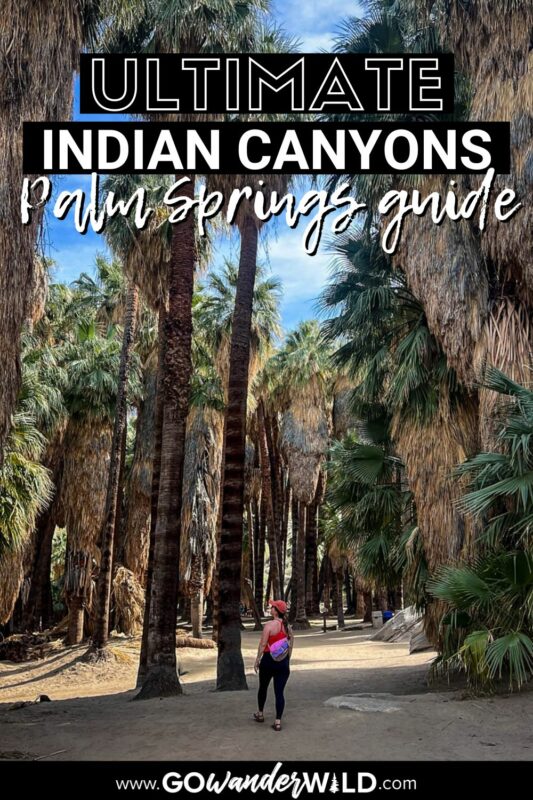
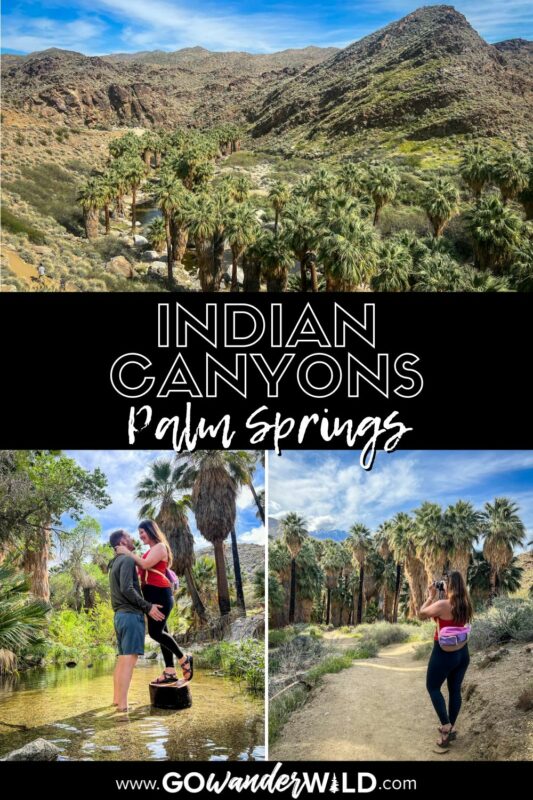
We want to hear from you!
Have you been hiking in Indian Canyons near Palm Springs before? What was your experience like? Are you planning to do some hiking near Palm Springs and have more questions? Leave us a comment below and we’ll do our best to get back to you!

